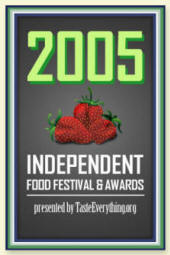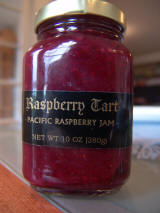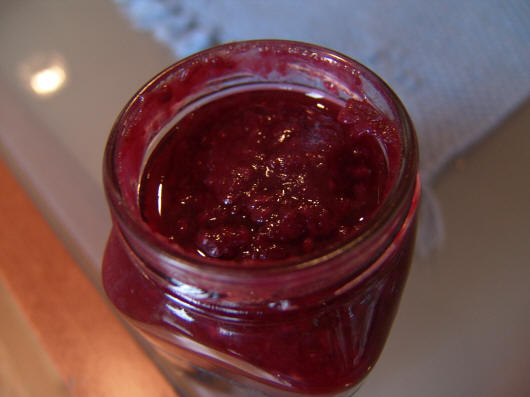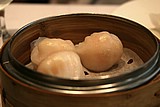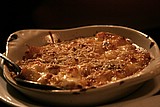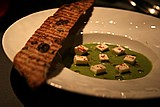Home |
Restaurants by City
|
Food Photography |
Archive | Philosophy |
![]()
Right now we are eating in Seattle, Washington.
|
Tuesday
2005
Permalink
|
When it comes to raspberry jam, I'm essentially
looking for a truckload full of raspberries. And all my life I've
been on a sort of background quest - to find a raspberry jam that
conveyed as closely as possible the essence of... well...
raspberries. It may seem like a simple task, but believe me, it's
not. Most raspberry jams suffer from three main problems. 1) They
are too gelled. Pectin is used to give Jam its gelatinous qualities.
Some Jams are just overly gelatinous. They have too much structure.
2) They are too sweet. I understand that some people feel just as
strongly about sour flavors as I do but in the other direction.
Every few months I will notice an interesting jar of raspberry jam on the shelf at the grocery store (or specialty store) and give it a whirl. And every few months I am disappointed. I think it was the fact that the Raspberry Tart Pacific Raspberry Jam had the word "tart" in the name that attracted me. I figured that it must at least be sour, and I could see the seeds through the glass of the jar, so we had a decent chance of getting something reasonable. Imagine my surprise when I got home, opened the jar, and found basically a container full of crushed fresh raspberries. Beautifully juicy. Perfectly sour. Filled with texture. Crushed fresh raspberries. Wow. I've been searching for at least twenty years, and my quest is finally complete. This stuff can be eaten anywhere you see fit, on ice cream, on toast, on a steak for all I care. (This is starting to feel a little Dr. Seussish.) And while this is a little embarrassing to admit, I've often eaten it just with a spoon. In fact, on those occasions, I've found myself down most of a jar before I realized I almost ate an entire jar of jam with a spoon. I don't know what's stopping me from just doing it. Sitting down with a new jar of Raspberry Tart Pacific Raspberry Jam and eating the whole thing with a spoon. I think society is keeping me down.
As you may have noticed from the logo at the start of this article, we are proud to participate in the first annual Independent Food Festival and Awards. In fact, the host of the festival, tasteeverything.org, is our sister website. These awards work a little differently than most in that each jury member gets to create and give out their own award. As a member of the inaugural jury I am proud to give the award for the: Most Perfect Raspberry Found in a Jar to Raspberry Tart, Pacific Raspberry
Jam, They have a whole line of jams you should try as well. Hopefully someday I can get down to Chico and con my way into a demonstration of how the Mountain Fruit people are capable of preserving the essence of fresh perfect raspberries in a jar. (Note: I got mine at the Wholefoods in Bellevue, WA. Not all Wholefoods have it, but I bet they can order it. I also found it online here.) ∞ Thirty food bloggers made up this year's awards jury. Check out the entire list of awards for more great food you may not have heard of.
|
|
Our Sponsors
Free Car Listings Hot Tubs Stools Saunas Bar Stools - Calendar and Event Schedules - Food Events and Calendars - Wine Events and Calendars - Digital Photography Resources - Software for Advertisers - Jewish Gifts and Judaica - Howard Stern Podcast - ponytailed blogger Jonathan Schwartz

Browse tastingmenu
Home |
Restaurants by City X |
Food Photography |
Archive | Philosophy |
![]()
Free eBooks: All About Apples
| Autumn Omakase
More:
Discussion |
Cool Food T-Shirts |
Ingredients
| Markets |
Recipes
Search |
Blog FAQ |
Other
Blogs
Best of tastingmenu
|
City View
Entry: July 6, 2006 |
Blue Plate
Entry: June 19, 2006 |
L'Atelier de Joël Robuchon
Entry: July 18, 2006 |
Browse by City
Boston | Chicago | Houston | Las Vegas | Los Angeles | Maui | New York | Philadelphia | Portland | San Francisco | Seattle | Toronto | Utah | Vancouver | Washington D.C.
Bangkok | Beijing | Hong Kong | Seoul | Tokyo
Amsterdam | Berlin | Italy | London | Madrid | Paris | Vienna
Browse by Month
2006
2005
2004
2003
2002
2001
Comments, questions, or feedback:
info / at / tastingmenu / dot / com
All pages Copyright (c) 2001-2006 tastingmenu.com
Last modified 01/30/07.
